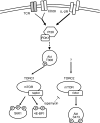mTOR: taking cues from the immune microenvironment
- PMID: 19604300
- PMCID: PMC2729523
- DOI: 10.1111/j.1365-2567.2009.03125.x
mTOR: taking cues from the immune microenvironment
Abstract
The ultimate outcome of T cell receptor recognition is determined by the context in which the antigen is encountered. In this fashion both antigen-presenting cells and T cells must integrate multiple environmental cues in the form of pathogen-associated molecular patterns, cytokines and accessory molecule signals. The mammalian target of rapamycin (mTOR) is an evolutionarily conserved serine/threonine kinase that plays a central role in integrating environmental signals critical to regulating metabolism and cell survival. In this paper we review the data demonstrating that mTOR integrates signals from the immune microenvironment and therefore facilitates the generation of the adaptive immune response. Specifically, we review the role of mTOR in promoting dendritic cell activation and maturation, in regulating full T cell activation versus anergy, and influencing the induction of regulatory T cells.
Figures


References
-
- Bretscher P, Cohn M. A theory of self–nonself discrimination. Science. 1970;169:1042–9. - PubMed
-
- Lafferty KJ, Cunningham AJ. A new analysis of allogeneic interactions. Aust J Exp Biol Med Sci. 1975;53:27–42. - PubMed
-
- Greenwald RJ, Freeman GJ, Sharpe AH. The B7 family revisited. Annu Rev Immunol. 2005;23:515–48. - PubMed
-
- Okazaki T, Honjo T. The PD-1-PD-L pathway in immunological tolerance. Trends Immunol. 2006;27:195–201. - PubMed
-
- Medzhitov R, Janeway CA., Jr How does the immune system distinguish self from nonself? Semin Immunol. 2000;12:185–8. - PubMed
Publication types
MeSH terms
Substances
Grants and funding
LinkOut - more resources
Full Text Sources
Other Literature Sources
Miscellaneous

